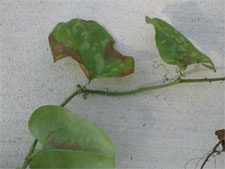Question and Answer – September 2010
If you’d like Neil’s help with a plant question, send it and a photo to him, then watch here next month for your answer. Questions without photos won’t be addressed here, but you’re welcome to call his radio programs (see notes elsewhere this issue).
Hi, all. Lots of questions this issue. I’ve chosen more than usual, because it seemed like there were some really good ones. I’ll give each my best shot, but I’ll need to be a bit brief. Thanks for writing.
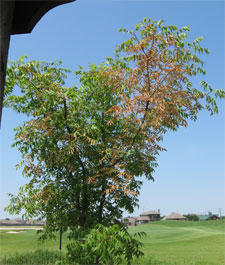
Question: I planted a Chinese pistachio because I was told it was drought-tolerant. It was in a container, and it had a 3-inch trunk. It gets full sun. What would have caused this problem? P.G., McKinney.
Answer: You’ll see this on 3- to 5-year-old Chinese pistachios and red oaks fairly often. It’s almost always caused by trunk damage brought on by sunscald. I can’t see the bottom of your tree’s trunk, but I do see that the surrounding plants seemed to be quite green at the time of your photo, so drought is probably not the cause. Look at the sunniest parts of the trunk, to see if cracks or decay have developed. All pistachios and red oaks should have their trunks wrapped at the time of planting and for 18 to 24 months thereafter. That’s pretty much not a negotiable thing. If the trunk is sound, I’m out of guesses. You might take several photos to the nursery where you purchased it. Good luck.
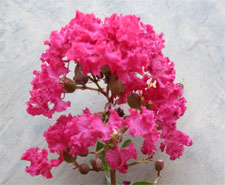
Question: Our neighbor has this crape myrtle. A nursery told us it was Pink Velour. It’s about 12-15 feet tall. Is that the right name? What varieties are best for my part of the state? No name given, Baylor County.
Answer: It looks like that could be the right call on variety. Here’s a link to the Varieties page of our Crape Myrtle Trails of McKinney website. You’ll see Pink Velour at the very top of this page: http://crapemyrtletrails.org/list. As to the best varieties, here is the list we compiled after consulting with several national authorities. We might not rank the Dazzles quite as high now, in retrospect, but the others remain as shown: http://crapemyrtletrails.org/best.
Question: What is this vine that has been taking over many places in my landscape, and how can I eliminate it? G. O’L. Boerne.
Answer: It’s smilax briar. Here’s what we have in the Most Asked Questions on my website:
http://www.neilsperry.com/maq/lawns/how-can-i-eliminate-the-briars-with-glossy-green-leaves.html
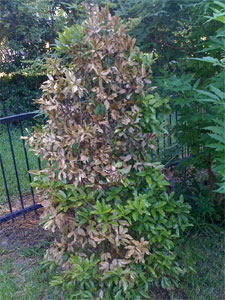
Question: What is happening with these shrubs that were planted 16 months ago? Some are hit worse than others. G.G., DFW area.
Answer: This is a holly, probably Oakland holly. In simple words, it got too dry. I’ve grown this and several dozen other types of hollies for more than 30 years, and I’ve never seen an insect or disease kill them. But, I’ve seen a lot of drought loss, especially in the first couple of years that they are in their new homes. These plants are grown in very lightweight potting soils at the wholesale nurseries (to minimize shipping costs), and that lightweight potting soil dries out far faster than the surrounding garden soil. They, like all new plantings, must be hand-watered during the summer for at least their first couple of years in the landscape.
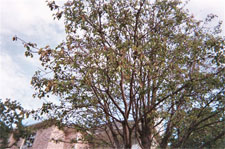
Question: What is wrong with this 16-year-old Bradford pear? It started to turn reddish very early. A.T., Highland Village.
Answer: It certainly looks like cotton root rot. Those are the normal symptoms for that soil-borne fungal disease, and pears are probably its favored victim. If you got 16 years out of any Bradford pear, you’ve almost set a record. Their life expectancy, between cotton root rot and poor branch strength, is probably closer to 10 or 12 years. Little Gem southern magnolia grows to the same height and width, yet it lives decades longer. Cotton root rot will not bother it.
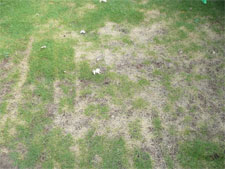
Question: What would cause this odd dead area in our lawn? We’ve tried fertilizer, pest killer, peat moss, fungicide, water — nothing has helped. The mower tracks appear the same day as mowing, and they last for weeks, but only in that spot. It continues to die. S. and B., Allen.
Answer: I don’t have a guaranteed answer, guys. This one is really odd. It almost looks like a gasoline spill that gets carried by the wheels. I’ve posted it in the hopes that someone else might recognize it and contact us. The only problem is that I may miss their reply, since I only look at postings that come in with photos. My Facebook page would be a perfect place for this specific photo and question. If anyone posts a suggestion there, please say that it’s in reference to S. and B. in Allen and their questions in e-gardens. We’ll give it a try.
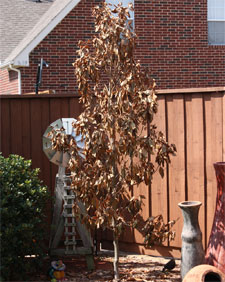
Question: Our magnolia tree is/was 3 years old. It had grown more than 2 feet this spring, and we commented how pretty it was. What could have happened? It received the same amount of water as our other trees. No name and no city given.
Answer: This tree simply got too dry. There is no other logical cause. See my answer above about the dry holly shrub. As for this tree having gotten the same amount of water as your other trees, remember that magnolias are native to moist areas of the southeastern U.S. Most of our other landscape trees can actually handle drought better –- especially if those other trees in your landscape are older and better established.
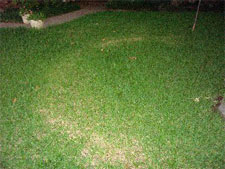
Question: Every year we have a semi-circle of yellowed St. Augustine. Each year, it’s a little more noticeable. The grass has never died in this semi-circle until this year. What would cause this? There are post oaks overhead. L.B., Arlington.
Answer: Best bet would be fairy rings. Those are communities of mushrooms and toadstools that spring up in full or partial circles. They often return to the same general space, living off decaying organic matter (grass clippings, dead tree roots, etc.) in that area. You will rarely see them actually kill the grass in their rings, but this year has been unusually brutal on St. Augustine anyway. Here is a link to an old Texas Agricultural Experiment Station photo of fairy rings.
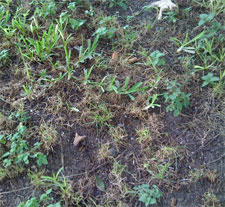
Question: I planted rye in my shaded St. Augustine last winter. The St. Augustine died out this year, while under similar trees in my back yard – where I did not plant rye – the St. Augustine survived. Does perennial rye weaken St. Augustine enough to kill it? I know the area is on the verge of being too shady. I’m hoping the dichondra will take over. E.T., Seguin.
Answer: You hit it right on the head. We mustn’t overseed St. Augustine that’s in the shade. The rye (even "perennial" rye) will eventually die out, but it does so too late into the summer. By then, it’s weakened and possibly even killed out the St. Augustine. By the way, the native dichondra, although pretty as a weed, doesn’t make much of a ground-covering plant. If you’re ready to move on from St. Augustine, consider mondograss, liriope, purple wintercreeper, Asian jasmine and ferns as your best options.
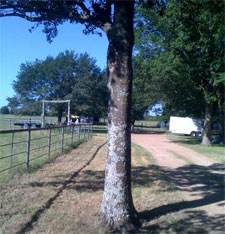
Question: I live on a tree-lined drive, and almost every tree has this blue-green color on it. Is it a fungus or a disease? What can I treat it with? S., Poetry (near Terrell).
Answer: These are lichens. They’re combinations of algae and funguses, and they are merely growing on the tree trunks. They do no damage at all to trees. In fact, if you recall mossy boulders of your life, those mosses were probably also lichens. So, they don’t require living tissues to survive. Just ignore them and free yourself to worry about something else.
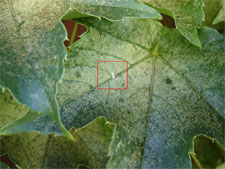
Question: What is going on with our Boston ivy? What can I do to stop it? Can I prevent it next year? D.M., Mesquite.
Answer: This is damage done by lace bugs. They turn leaves of Boston ivy, pyracanthas, azaleas, bur oaks, boxwoods, sycamores, cotoneasters and a host of other plants manila-folder beige. You won’t always see the clear-winged adult insects, but you’ll see their black droppings on the backs of affected leaves. They won’t kill the plants, so be armed with an appropriate insecticide late next spring, at first signs of the tiny mottling. You could spray them now, if you wish. Follow that with an all-nitrogen fertilizer, and soak it into the soil deeply to help kick the plants back into good fall growth.

